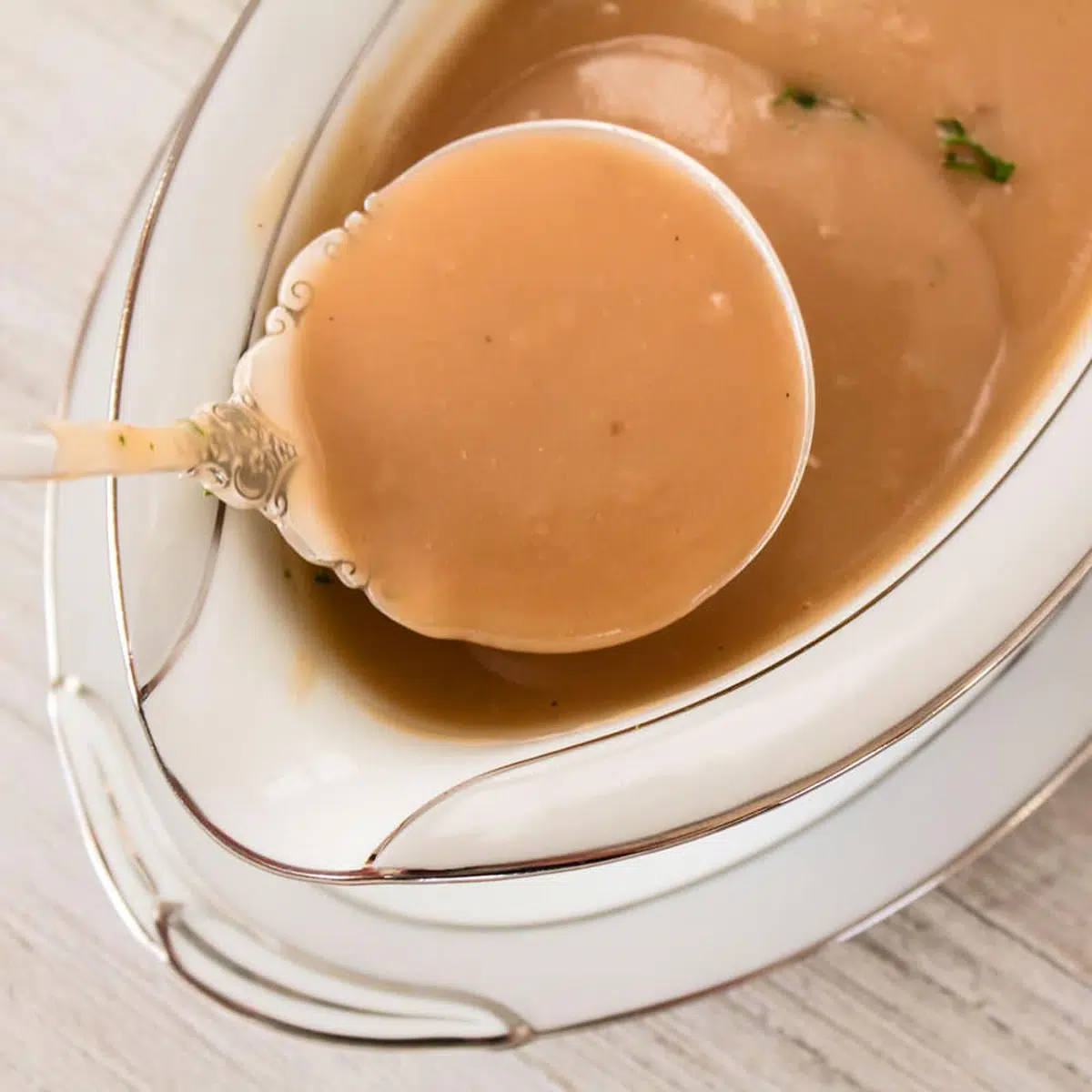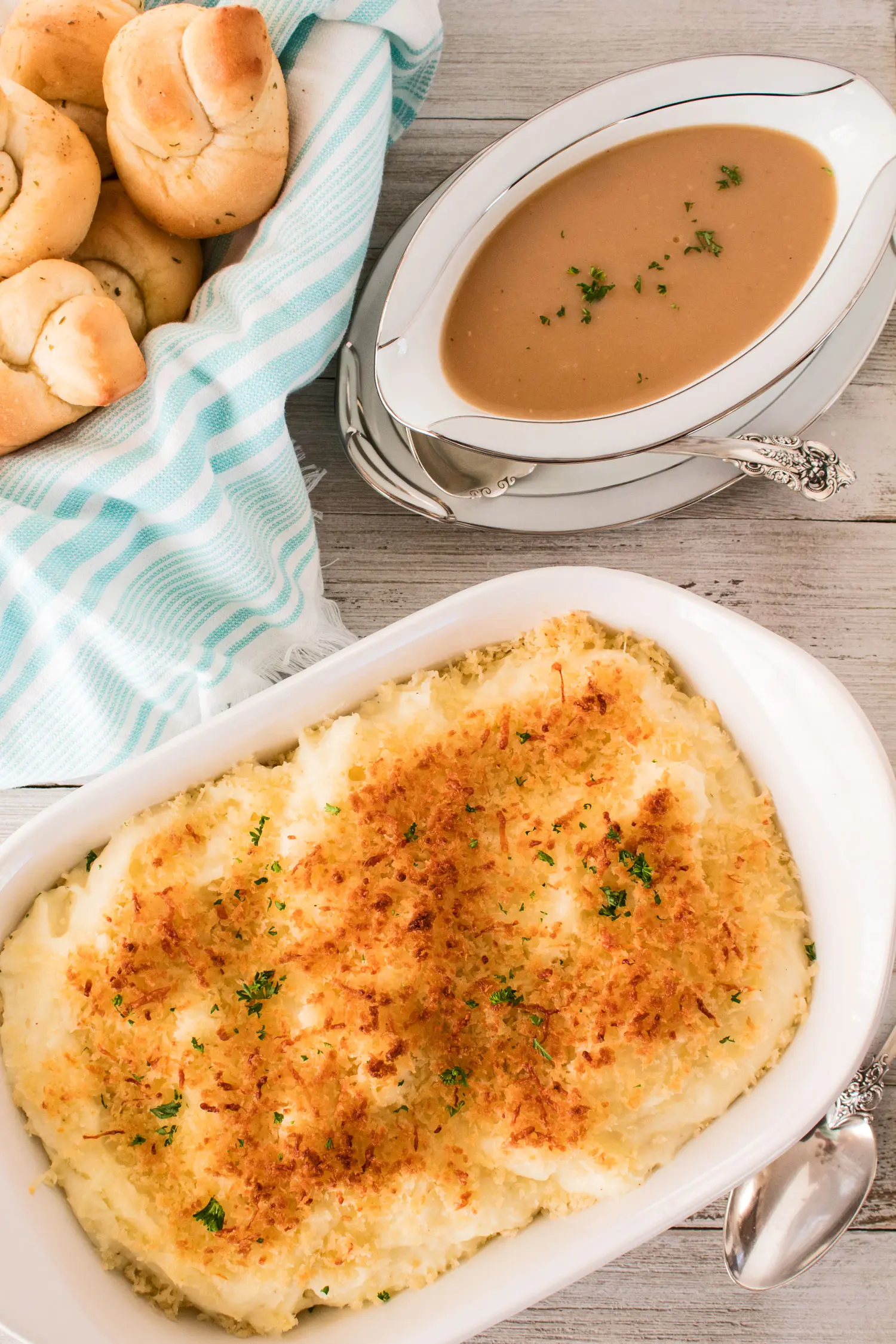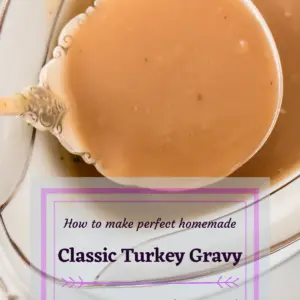Classic turkey gravy is made using roasted turkey drippings and slowly simmered turkey neck and giblets for a flavorful gravy! It is rich, creamy, and amazingly smooth. This super easy gravy takes just minutes to prepare and you'll be so thankful you skipped the store-bought version!
Best Turkey Gravy Using Giblets
Turkey gravy is a family tradition during the holidays whenever turkey is served. This homemade turkey gravy is so yummy. It is made using roasted turkey drippings and slowly simmered turkey neck and giblets for a wonderfully flavorful gravy.
To ensure that you don't have an issue with running out of gravy at mealtime, this recipe will make a large batch of gravy. You wouldn't want to come short of being able to fill your mountain of mashed potatoes appropriately!

Jump to:
🥘 Turkey Gravy Ingredients
The turkey neck and giblets typically come in a bag inside of your turkey, just go ahead and discard the liver. Heavy cream is optional, but completely recommended!
- Turkey Drippings - Separate the fat from your turkey drippings and then combine the drippings with broth to make a total of 8 cups.
- Chicken Broth - 8 cups of chicken broth or turkey stock to combine with your turkey drippings.
- Bay Leaf - 1 bay leaf.
- Thyme - 2 - 3 sprigs of fresh thyme (or ½ tablespoon dried).
- Butter - 1 tablespoon of salted butter.
- Flour - ½ cup of all-purpose flour.
- Heavy Cream (optional) - ¼ cup of heavy cream.
- Turkey Neck & Giblets - Remove the liver and discard.
- Salt & Pepper - Add salt & pepper to taste.
🔪 How To Make Classic Turkey Gravy
This gravy is super easy to make! Just don't forget to let your giblets simmer while the turkey is in the oven! You're going to need a saucepan and measuring cups.
This recipe will make a decent amount of gravy, so don't worry about running out!
Simmer The Giblets & Drain Drippings
- Add giblets & neck to the saucepan. Place giblets and neck into a saucepan with 2 cups chicken stock and add water to cover the neck and giblets with 2 inches of liquid.
- Add in seasonings. Add 1 bay leaf, and 2 sprigs of thyme and then simmer on low while the turkey is roasting.
- Drain drippings. After the turkey has finished cooking and is resting, drain off the drippings (which includes 2 cups of broth when we roast our turkey) from the roasting pan into a de-greasing cup or a 4-cup Pyrex glass liquid measuring cup. Make sure to scrape all of the browned bits from the roasting pan, using a wooden spoon, and into the cup with the drippings.
- Remove fat. Allow the drippings and fat to separate, the fat will rise and start to solidify. So even if you don't have a de-greasing cup, you can spoon the separated fat from the top of your measuring cup (after about 10 minutes)
Making The Turkey Gravy
- Preheat. Bring a large saucepan to medium-high heat.
- Make roux. Add about a ½ cup of the separated fat to the heated saucepan and sprinkle the½ cup of flour into the pan, stirring constantly, to make your roux. Keep stirring as your roux darkens, approximately 3-4 minutes. *You can enhance your gravy flavor by allowing the roux to get darker, however, the darker the roux gets the less thickened your resulting gravy will be.
- Make liquid portion. Combine the simmered broth from the turkey neck and giblets (strained) to the liquid portion of the turkey drippings (after the fat has been removed) to make 8 cups of liquid, add turkey stock or chicken broth as needed to reach the 8 cup portion.
- Add roux. Reheat the liquid, if needed, as the liquid should be hot when added to your roux. Gradually whisk in the liquid (whisking constantly to prevent lumps) until all of the liquid is added.
- Thicken. Bring the gravy to a boil, then reduce heat to medium-low. Simmer until thickened, whisking occasionally, for about 10 minutes. *You can add the chopped giblets and shredded meat from the turkey neck before simmering if desired.
- Finish. Remove from heat and finish with 1 tablespoon of butter, salt, and pepper to taste. Add an optional ¼ cup of heavy cream for a super creamy gravy, or to thicken your gravy (without using additional flour or cornstarch).
Of course, this turkey gravy is perfect for your Thanksgiving roasted turkey! You can also pour it over your favorite roasted garlic mashed potatoes or use some dinner rolls or challah bread to soak it up!

💭 Angela's Pro Tips & Recipe Notes
- Whatever herb or herbs I have on hand, I like to add to my simmering turkey neck and giblets. Thyme, rosemary, or sage - or a combination are great!
- Some people really enjoy having the giblets finely chopped and included in the resulting turkey gravy. Feel free to add them to your gravy!
- This recipe is using two cups of drippings. I have never had any issue with being short of drippings (especially when I use 2 cups of chicken broth in the roasting pan of my turkey - to baste the turkey with while cooking).
- To store: Store your homemade turkey gravy in an airtight container in the fridge for up to 3 days.
- To reheat: Pour your leftover gravy into a saucepan, add some broth (the more you add, the thinner it will be), and then cook over medium-low heat until warmed all the way through.
❓ What Do I Do With Turkey Neck & Giblets?
One step that I do, that is completely optional but it does help to enhance that wonderful turkey gravy flavor - is to cover the neck and giblets with broth and water, and allow them to slowly simmer while the turkey is roasting.
This process makes a wonderfully flavorful base for turkey gravy!
❓ How Do I Thicken Gravy?
Typically, a portion of flour or cornstarch is used, combined with cold water (using more water with cornstarch than with flour) to make a slurry, then whisked into your gravy. If you do this at the end of the gravy-making process, you could end up with lumpy gravy, which is why I prefer to add heavy cream at the end to finish thickening up the gravy.
❓ How Do I Get Lumps Out Of My Gravy?
Making gravy without lumps is easier when you make your roux with an appropriate amount of flour at the beginning of the cooking process. If you do need to add more flour or cornstarch to thicken your gravy, and you end up with lumpy gravy, you can run the gravy through cheesecloth or a fine sieve strainer to remove the lumps.
I prefer to add some heavy cream at the end of my gravy-making process. It adds a richness that is divine, plus it naturally thickens up your gravy!
🦃 More Holiday Dinner Dishes
- Oven Roasted Turkey is another great Thanksgiving turkey dinner staple to carve up at your family's dinner table, no matter the time of year!
- Smoked Turkey for those of you that are lucky enough to have mild weather during November, head outside and try this tasty turkey recipe!
- Parmesan Roasted Mashed Potatoes are an elevated mash potato recipe to serve alongside your platter of turkey, gravy, sides, and rolls!
- Skillet Brown Sugar Glazed Carrots add a flavorful vegetable side dish to the mix for any dinner menu!
- Candied Yams are another holiday must-have side dish, right up there with this turkey gravy recipe!
- Oatmeal Rolls simply cannot be skipped and you'll get rave reviews on these tender, tasty rolls that are so easy to make!!
Do you love a recipe you tried? Please leave a 5-star 🌟rating in the recipe card below and/or a review in the comments section further down the page.
Stay in touch with me through social media @ Pinterest, Facebook, Instagram, or Twitter! Subscribe to the newsletter today (no spam, I promise)! Don't forget to tag me when you try one of my recipes!
📖 Recipe Card
Classic Turkey Gravy
Ingredients
- 2 cups drippings from oven roasted turkey (separate fat, then combine with broth to make a total of 8 cups liquid)
- 6 cups chicken broth or turkey stock (combine with drippings to make a total of 8 cups liquid)
- 1 bay leaf
- 2-3 sprigs thyme (fresh, or ½ tablespoon dried - rosemary and/or sage would work)
- turkey neck and giblets (from turkey - remove the liver and discard)
- ½ cup all-purpose flour
- 1 tablespoon butter (salted)
- salt & white pepper (to taste)
- ¼ cup heavy cream (optional)
(Note: 2x or 3x only changes the ingredient list)
Instructions
- Remove turkey neck and giblets (discard the liver) from raw, thawed turkey before roasting. Place in a saucepan with 2 cups chicken stock and add water to cover the neck and giblets with 2 inches of liquid.
- Add bay leaf, herbs, and seasoning (salt, pepper, thyme, rosemary, and/or sage, peppercorns) and simmer on low while the turkey is roasting.
- When the turkey is out of the oven, remove to a cutting board or serving platter, cover and allow to rest. Drain off the drippings (which includes 2 cups broth when we roast our turkey) from the roasting pan into a de-greasing cup or a 4-cup Pyrex glass liquid measuring cup. Make sure to scrape all of the browned bits from the roasting pan, using a wooden spoon, and into the cup with the drippings.
- Allow the drippings and fat to separate, the fat will rise and start to solidify. So even if you don't have a de-greasing cup, you can spoon the separated fat from the top of your measuring cup (after about 10 minutes)
- Bring a large saucepan to medium high heat. Add about a ½ cup of the separated fat to the heated saucepan and sprinkle the flour into the pan, stirring constantly, to make your roux. Keep stirring as your roux darkens, approximately 3-4 minutes. *You can enhance your gravy flavor by allowing the roux to get darker, however, the darker the roux gets the less thickened your resulting gravy will be.
- For your liquid: combine the simmered broth from the turkey neck and giblets (strained) to the liquid portion of the turkey drippings (after the fat has been removed) to make 8 cups of liquid, add turkey stock or chicken broth as needed to reach the 8 cup portion.
- Reheat the liquid, if needed, as the liquid should be hot when added to your roux. Gradually whisk in the liquid (whisking constantly to prevent lumps) until all of the liquid is added.
- Bring the gravy to a boil, then reduce heat to medium low. Simmer until thickened, whisking occasionally, for about 10 minutes. *You can add the chopped giblets and shredded meat from the turkey neck before simmering, if desired.
- Remove from heat and finish with 1 tablespoon of butter, salt and pepper to taste. Add optional heavy cream for a super creamy gravy, or to thicken your gravy (without using additional flour or cornstarch).
Notes
- Whatever herb or herbs I have on hand, I like to add to my simmering turkey neck and giblets. Thyme, rosemary, or sage - or a combination are great!
- Some people really enjoy having the giblets finely chopped and included in the resulting turkey gravy. Feel free to add them to your gravy!
- This recipe is using two cups of drippings. I have never had any issue with being short of drippings (especially when I use 2 cups of chicken broth in the roasting pan of my turkey - to baste the turkey with while cooking).
- To store: Store your homemade turkey gravy in an airtight container in the fridge for up to 3 days.
- To reheat: Pour your leftover gravy into a saucepan, add some broth (the more you add, the thinner it will be), and then cook over medium-low heat until warmed all the way through.



Pam says
Rich and delicious, was perfect for turkey dinner!
Beth says
This is how we make our gravy too! Gravy is at once so simple and yet it's all about technique and the little extra steps to really give it the right texture and flavor. Fantastic instructions. Thank you.
Angela @ BakeItWithLove.com says
It helps that we roast turkey every month or two, lots of practice in gravy making! Thank you Beth!
Jere Cassidy says
Gravy is the most important part of the turkey dinner. Yours looks creamy and rich. Perfect for potatoes.
Angela @ BakeItWithLove.com says
My husband agrees! He's all about the gravy. Thank you Jere!